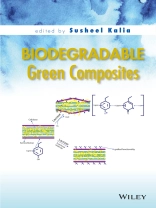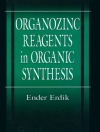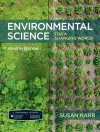This book comprehensively addresses surface modification of natural fibers to make them more effective, cost-efficient, and environmentally friendly. Topics include the elucidation of important aspects surrounding chemical and green approaches for the surface modification of natural fibers, the use of recycled waste, properties of biodegradable polyesters, methods such as electrospinning, and applications of hybrid composite materials.
Tabela de Conteúdo
Contributors xii
Preface xiv
1 Biodegradable Green Composites 1
Sreerag Gopi, Anitha Pius, and Sabu Thomas
1.1 Introduction 2
1.2 Biodegradable Polymers 2
1.2.1 Starch 2
1.2.2 Cellulose 4
1.2.3 Chitin and Chitosan 4
1.2.4 Proteins 5
1.3 Nanofillers for Composites 5
1.3.1 Cellulose‐Based Nanofillers 5
1.3.2 Carbon Nanotube 7
1.3.3 Clay 7
1.3.4 Functional Fillers 7
1.4 Nanocomposites from Renewable Resources 8
1.4.1 Cellulose Nanocomposites 9
1.4.2 CNT Nanocomposites 9
1.4.3 Clay Nanocomposites 10
1.4.4 Functional Nanocomposites 10
1.5 Processing of Green Composites 10
1.6 Applications 11
1.6.1 Packaging 11
1.6.2 Electronics, Sensor, and Energy Applications 11
1.6.3 Medicinal Applications 12
1.7 Conclusion 12
References 12
2 Surface Modification of Natural Fibers Using Plasma Treatment 18
Danmei Sun
2.1 Introduction 19
2.1.1 Natural Fiber Materials and their Properties 19
2.1.2 Conventional Modification Methods and Drawbacks 19
2.1.3 Plasma Environment and the Advantages of Plasma Surface Modification 20
2.2 Mechanisms of Plasma Treatment and Types of Plasma Machines 21
2.2.1 Principle of Plasma Surface Modification 21
2.2.2 Interactive Mechanisms between Plasma and Substrates 22
2.2.3 Types of Plasma Treatment Systems 24
2.3 Effects and Applications of Plasma Treatment 27
2.3.1 Surface Morphology and Chemical Composition Change 27
2.3.2 Improved Hydrophilicity and Efficiency in Aqueous Processes 28
2.3.3 Improved Hydrophobicity 31
2.3.4 Mechanical Properties Affected by Plasma Treatment 33
2.3.5 Medical Applications of Plasma Treatment 34
2.3.6 Plasma‐Modified Fibers in Polymer Composites 34
2.3.7 Other Areas of Applications 35
2.4 Conclusions and Industrial Implications 35
References 35
3 Reinforcing Potential of Enzymatically Modified Natural Fibers 40
Levent Onal and Yekta Karaduman
3.1 Introduction 41
3.2 Enzymes 42
3.2.1 A Brief History 42
3.2.2 Classification and Nomenclature 43
3.2.3 Enzyme Structure 43
3.2.4 Enzymatic Catalysis 44
3.3 Natural Fibers as Enzyme Substrates 45
3.3.1 Physical Properties of Lignocellulosic Fibers 46
3.3.2 Chemical Properties and Composition of Lignocellulosic Fibers 47
3.3.2.1 Cellulose 47
3.3.2.2 Hemicellulose 49
3.3.2.3 Lignin 49
3.3.2.4 Pectin 50
3.3.2.5 Other Aromatic Compounds 51
3.3.2.6 Fats, Waxes, and Lipids 51
3.4 Types of Enzymes Used in Natural Fiber Modification 51
3.4.1 Cellulases 51
3.4.2 Xylanases 52
3.4.3 Pectinases 53
3.4.4 Laccases 53
3.5 Effect of Enzymatic Treatment on the Structure and Properties of Natural Fibers 54
3.6 Polymer Composites Reinforced with Enzymatically Modified Natural Fibers 62
3.7 Enzyme‐Assisted Biografting Methods 69
3.8 Conclusions 73
References 74
4 Recent Developments in Surface Modification of Natural Fibers for their use in Biocomposites 80
Jaspreet Kaur Bhatia, Balbir Singh Kaith, and Susheel Kalia
4.1 Introduction 81
4.2 Biocomposites 82
4.2.1 Classification: Biomass Derived and Petroleum‐Derived Matrix 83
4.2.2 Advantage over Traditional Composites 86
4.3 Natural Fiber: Structure and Composition 86
4.4 Surface Modification of Natural Fibers 89
4.4.1 Silylation, Esterification, and other Surface Chemical Modifications 89
4.4.2 Noncovalent Surface Chemical Modifications 93
4.4.3 Cationization 95
4.4.4 Polymer Grafting 95
4.4.5 TEMPO‐Mediated Oxidation 98
4.4.6 Green Modification 100
4.5 Biocomposites: Recent Trends and Opportunities for the Future 100
4.6 Biodegradability of Biocomposites 101
4.7 Conclusions 103
References 105
5 Nanocellulose‐Based Green Nanocomposite Materials 118
Qi Zhou and Núria Butchosa
5.1 Introduction 119
5.2 Nanocellulose 119
5.2.1 Cellulose Nanocrystals 120
5.2.2 Cellulose Nanofibrils 120
5.2.3 Bacterial Cellulose 122
5.3 Composite Matrices 122
5.3.1 Cellulose and Cellulose Derivatives 122
5.3.2 Hemicelluloses and other Polysaccharides 123
5.3.3 Starch 124
5.3.4 Chitin and Chitosan 125
5.3.5 Proteins 126
5.3.6 Polylactic Acid and Poly(ε‐Caprolactone) 127
5.3.7 Inorganic Nanoparticles 128
5.4 Composite Properties 129
5.4.1 Thermal and Mechanical Properties 129
5.4.2 Barrier Properties 130
5.4.3 Antimicrobial Properties 133
5.4.4 Optical Properties 134
5.5 Conclusions 136
References 137
6 Poly(Lactic Acid) Hybrid Green Composites 149
Mahbub Hasan, Azman Hassan, and Zainoha Zakaria
6.1 Introduction 150
6.2 Manufacturing Techniques of PLA Hybrid Green Composites 151
6.2.1 Melt Mixing/Blending 151
6.2.2 Extrusion/Injection Molding 153
6.2.3 Other Techniques 155
6.3 Properties of PLA Hybrid Green Composites 156
6.3.1 Mechanical Properties 156
6.3.1.1 Tensile Properties 156
6.3.1.2 Flexural Properties 157
6.3.1.3 Impact Strength 158
6.3.2 Dynamic Mechanical Properties 158
6.3.3 Thermal Properties 160
6.3.3.1 Thermogravimetric Analysis 160
6.3.3.2 Differential Scanning Calorimetry 162
6.3.4 Surface Morphology 162
6.3.5 Electrical Properties 163
6.4 Applications of PLA Hybrid Green Composites 164
6.5 Conclusions 164
References 164
7 Lignin/Nanolignin and their Biodegradable Composites 167
Anupama Rangan, M.V. Manjula, K.G. Satyanarayana, and Reghu Menon
7.1 Introduction 168
7.1.1 Renewable Bioresources-Sustainability and Biodegradability Issues 168
7.1.2 Nanotechnology and Application of Nanotechnology (Specifically for Cellulose and Lignin) 170
7.2 Lignin 170
7.2.1 Structure, Chemical Nature, Complexity, and Linkage Heterogeneity 170
7.2.2 Types, Structure, Properties, and Uses of Modified/Processed Lignin 172
7.2.2.1 Kraft Lignin 173
7.2.2.2 Soda Lignin 173
7.2.2.3 Lignosulfonates 173
7.2.2.4 Organosolv Lignin 175
7.2.2.5 Hydrolysis Lignin 175
7.3 Nanolignin and Methods of Preparation of Nanolignin 175
7.3.1 Precipitation Method 175
7.3.2 Chemical Modification Method 178
7.3.3 Electrospinning Followed by Surface Modification 178
7.3.4 Freeze Drying Followed by Thermal Stabilization and Carbonization 179
7.3.5 Supercritical Antisolvent Technology 179
7.3.6 Chemomechanical Methods 180
7.3.7 Nanolignin by Self‐Assembly 181
7.3.8 Template‐Mediated Synthesis of Lignin‐based Nanotubes and Nanowires 181
7.4 Characterization of Lignin Nanoparticles 183
7.4.1 Microscopy 183
7.4.2 Thermal Analysis 185
7.4.3 X‐Ray Diffraction 186
7.4.4 Other Methods 186
7.5 Lignin Composites/Nanolignin‐Based “Green” Composites 186
7.5.1 Lignin‐based Thermoplastic Polymer Composites 186
7.5.2 Rubber‐based Lignin Composites 187
7.5.3 Lignin‐reinforced Biodegradable Composites 187
7.5.4 Lignin‐reinforced Foam‐based Composites 188
7.5.5 Lignin‐based Composite Coatings 188
7.5.6 Synthesis of Lignin–PLA Copolymer Composites 190
7.5.7 Nanolignin‐based “Green” Composites 190
7.6 Potential Applications of Lignin/Nanolignin 190
7.7 Perspectives and Concluding Remarks 191
Acknowledgments 192
References 192
Web Site References 198
8 Starch‐Based “Green” Composites 199
K.G. Satyanarayana and V.S. Prasad
8.1 Introduction 200
8.1.1 Starch 200
8.1.1.1 Thermoplastic Starch 202
8.1.1.2 Starch Nanocrystals 203
8.1.1.3 Structure and Properties of Starch/TPS 207
8.2 Starch‐Based Composites 215
8.2.1 Processing Techniques/Methods 215
8.2.1.1 Processing of Starch‐based Microcomposites 215
8.2.1.2 Processing of Starch‐based Nanocomposites 220
8.2.2 Structure and Properties of Starch-Polymer Systems (Blends/Composites) 222
8.2.2.1 Starch-Polymer Systems 222
8.2.2.2 Starch–Natural Materials‐based “Green” Composites 239
8.2.2.3 Starch‐based Nanocomposites 257
8.2.2.4 Starch Nanoparticles in Composites 269
8.3 Applications 272
8.4 Perspectives 275
8.5 Concluding Remarks 275
Acknowledgments 276
References 277
9 Green Composite Materials Based on Biodegradable Polyesters 299
Pramendra Kumar Bajpai
9.1 Introduction 299
9.2 Fabrication Techniques for Green Composites 301
9.2.1 Hand Lay‐Up Fabrication Technique 301
9.2.2 Compression Molding 302
9.2.3 Injection Molding Fabrication Technique 304
9.2.4 Resin Transfer Fabrication Technique 306
9.2.5 Pultrusion Fabrication Technique 307
9.3 Processing of Green Composites Through Microwave Heating 308
9.4 Application of Green Composite 308
9.5 Concluding Remark 309
References 309
10 Applications of Green Composite Materials 312
Koronis Georgios, Arlindo Silva, and Samuel Furtado
10.1 Introduction 313
10.2 Green Composite Materials 313
10.2.1 Reinforcement 314
10.2.2 The Matrix 316
10.3 Consumer Products 317
10.4 Biomedical Applications 319
10.5 Packaging 321
10.6 Transportation Industry 322
10.7 Construction 326
10.8 Energy Industry 327
10.9 Sports and Leisure Industry 327
10.9.1 Boat Hulls and Canoes 328
10.9.2 Snowboards/Skis and Surfboards 328
10.9.3 Toys 329
10.9.4 Musical Instruments 329
10.10 Conclusions 330
References 330
Index 338
Sobre o autor
Susheel Kalia is Researcher in Department of Civil, Chemical, Environmental and Materials Engineering at University of Bologna, Italy. Kalia’s research is in the field of biocomposites, nanocomposites, conducting polymers, cellulose nanofibers, inorganic nanoparticles, hybrid materials, hydrogels and cryogenics. The author of many international papers, articles and chapters, he has published many review articles on polymeric composites based on natural fibers. Kalia’s editorial activities include work as a reviewer and memberships of editorial boards for various international journals. He is also a member of a number of professional organizations, including the Asian Polymer Association, Indian Cryogenics Council, the Society for Polymer Science, Indian Society of Analytical Scientists, and the International Association of Advanced Materials.












